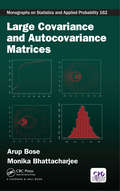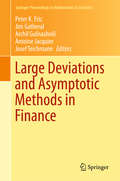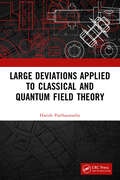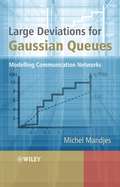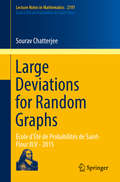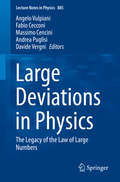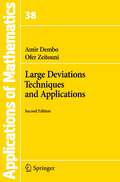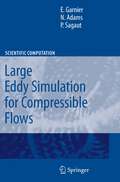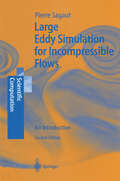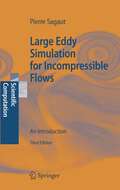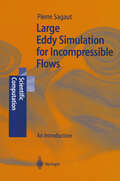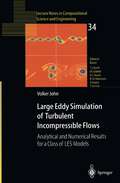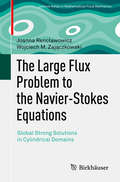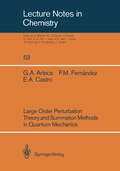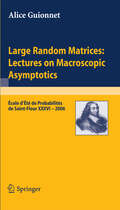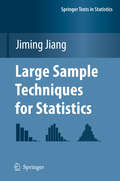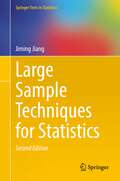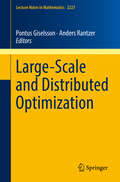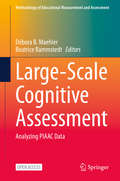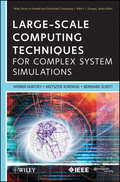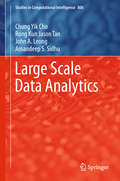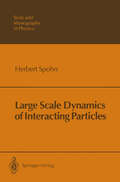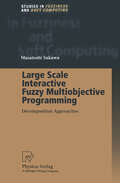- Table View
- List View
Large Covariance and Autocovariance Matrices (Chapman & Hall/CRC Monographs on Statistics and Applied Probability)
by Arup Bose Monika BhattacharjeeLarge Covariance and Autocovariance Matrices brings together a collection of recent results on sample covariance and autocovariance matrices in high-dimensional models and novel ideas on how to use them for statistical inference in one or more high-dimensional time series models. The prerequisites include knowledge of elementary multivariate analysis, basic time series analysis and basic results in stochastic convergence. Part I is on different methods of estimation of large covariance matrices and auto-covariance matrices and properties of these estimators. Part II covers the relevant material on random matrix theory and non-commutative probability. Part III provides results on limit spectra and asymptotic normality of traces of symmetric matrix polynomial functions of sample auto-covariance matrices in high-dimensional linear time series models. These are used to develop graphical and significance tests for different hypotheses involving one or more independent high-dimensional linear time series. The book should be of interest to people in econometrics and statistics (large covariance matrices and high-dimensional time series), mathematics (random matrices and free probability) and computer science (wireless communication). Parts of it can be used in post-graduate courses on high-dimensional statistical inference, high-dimensional random matrices and high-dimensional time series models. It should be particularly attractive to researchers developing statistical methods in high-dimensional time series models. Arup Bose is a professor at the Indian Statistical Institute, Kolkata, India. He is a distinguished researcher in mathematical statistics and has been working in high-dimensional random matrices for the last fifteen years. He has been editor of Sankhyā for several years and has been on the editorial board of several other journals. He is a Fellow of the Institute of Mathematical Statistics, USA and all three national science academies of India, as well as the recipient of the S.S. Bhatnagar Award and the C.R. Rao Award. His first book Patterned Random Matrices was also published by Chapman & Hall. He has a forthcoming graduate text U-statistics, M-estimates and Resampling (with Snigdhansu Chatterjee) to be published by Hindustan Book Agency. Monika Bhattacharjee is a post-doctoral fellow at the Informatics Institute, University of Florida. After graduating from St. Xavier's College, Kolkata, she obtained her master’s in 2012 and PhD in 2016 from the Indian Statistical Institute. Her thesis in high-dimensional covariance and auto-covariance matrices, written under the supervision of Dr. Bose, has received high acclaim.
Large Deviations and Asymptotic Methods in Finance (Springer Proceedings in Mathematics & Statistics #110)
by Peter K. Friz Jim Gatheral Archil Gulisashvili Antoine Jacquier Josef TeichmannTopics covered in this volume (large deviations, differential geometry, asymptotic expansions, central limit theorems) give a full picture of the current advances in the application of asymptotic methods in mathematical finance, and thereby provide rigorous solutions to important mathematical and financial issues, such as implied volatility asymptotics, local volatility extrapolation, systemic risk and volatility estimation. This volume gathers together ground-breaking results in this field by some of its leading experts.Over the past decade, asymptotic methods have played an increasingly important role in the study of the behaviour of (financial) models. These methods provide a useful alternative to numerical methods in settings where the latter may lose accuracy (in extremes such as small and large strikes, and small maturities), and lead to a clearer understanding of the behaviour of models, and of the influence of parameters on this behaviour.Graduate students, researchers and practitioners will find this book very useful, and the diversity of topics will appeal to people from mathematical finance, probability theory and differential geometry.
Large Deviations Applied to Classical and Quantum Field Theory
by Harish ParthasarathyThis book deals with a variety of problems in Physics and Engineering where the large deviation principle of probability finds application. Large deviations is a branch of probability theory dealing with approximate computation of the probabilities of rare events. It contains applications of the LDP to pattern recognition problems like analysis of the performance of the EM algorithm for optimal parameter estimation in the presence of weak noise, analysis and control of non-Abelian gauge fields in the presence of noise, and quantum gravity wherein we are concerned with perturbation to the quadratic component of the Einstein-Hilbert Hamiltonian caused by higher order nonlinear terms in the position fields and their effect on the Gibbs statistics and consequently quantum probabilities of events computed using the quantum Gibbs state. The reader will also find in this book applications of LDP to quantum filtering theory as developed by Belavkin based on the celebrated Hudson-Parthasarathy quantum stochastic calculus. Print edition not for sale in South Asia (India, Sri Lanka, Nepal, Bangladesh, Pakistan and Bhutan).
Large Deviations Applied to Classical and Quantum Field Theory
by Harish ParthasarathyThis book deals with a variety of problems in Physics and Engineering where the large deviation principle of probability finds application. Large deviations is a branch of probability theory dealing with approximate computation of the probabilities of rare events. It contains applications of the LDP to pattern recognition problems like analysis of the performance of the EM algorithm for optimal parameter estimation in the presence of weak noise, analysis and control of non-Abelian gauge fields in the presence of noise, and quantum gravity wherein we are concerned with perturbation to the quadratic component of the Einstein-Hilbert Hamiltonian caused by higher order nonlinear terms in the position fields and their effect on the Gibbs statistics and consequently quantum probabilities of events computed using the quantum Gibbs state. The reader will also find in this book applications of LDP to quantum filtering theory as developed by Belavkin based on the celebrated Hudson-Parthasarathy quantum stochastic calculus. Print edition not for sale in South Asia (India, Sri Lanka, Nepal, Bangladesh, Pakistan and Bhutan).
Large Deviations for Gaussian Queues: Modelling Communication Networks
by Michel MandjesIn recent years the significance of Gaussian processes to communication networks has grown considerably. The inherent flexibility of the Gaussian traffic model enables the analysis, in a single mathematical framework, of systems with both long-range and short-range dependent input streams. Large Deviations for Gaussian Queues demonstrates how the Gaussian traffic model arises naturally, and how the analysis of the corresponding queuing model can be performed. The text provides a general introduction to Gaussian queues, and surveys recent research into the modelling of communications networks. Coverage includes: Discussion of the theoretical concepts and practical aspects related to Gaussian traffic models. Analysis of recent research asymptotic results for Gaussian queues, both in the large-buffer and many-sources regime. An emphasis on rare-event analysis, relying on a variety of asymptotic techniques. Examination of single-node FIFO queuing systems, as well as queues operating under more complex scheduling disciplines, and queuing networks. A set of illustrative examples that directly relate to important practical problems in communication networking. A large collection of instructive exercises and accompanying solutions. Large Deviations for Gaussian Queues assumes minimal prior knowledge. It is ideally suited for postgraduate students in applied probability, operations research, computer science and electrical engineering. The book’s self-contained style makes it perfect for practitioners in the communications networking industry and for researchers in related areas.
Large Deviations for Random Graphs: École d'Été de Probabilités de Saint-Flour XLV - 2015 (Lecture Notes in Mathematics #2197)
by Sourav ChatterjeeThis book addresses the emerging body of literature on the study of rare events in random graphs and networks. For example, what does a random graph look like if by chance it has far more triangles than expected? Until recently, probability theory offered no tools to help answer such questions. Important advances have been made in the last few years, employing tools from the newly developed theory of graph limits. This work represents the first book-length treatment of this area, while also exploring the related area of exponential random graphs. All required results from analysis, combinatorics, graph theory and classical large deviations theory are developed from scratch, making the text self-contained and doing away with the need to look up external references. Further, the book is written in a format and style that are accessible for beginning graduate students in mathematics and statistics.
Large Deviations in Physics: The Legacy of the Law of Large Numbers (Lecture Notes in Physics #885)
by Angelo Vulpiani Fabio Cecconi Massimo Cencini Andrea Puglisi Davide VergniThis book reviews the basic ideas of the Law of Large Numbers with its consequences to the deterministic world and the issue of ergodicity. Applications of Large Deviations and their outcomes to Physics are surveyed. The book covers topics encompassing ergodicity and its breaking and the modern applications of Large deviations to equilibrium and non-equilibrium statistical physics, disordered and chaotic systems, and turbulence.
Large Deviations Techniques and Applications (Stochastic Modelling and Applied Probability #38)
by Amir Dembo Ofer ZeitouniLarge deviation estimates have proved to be the crucial tool required to handle many questions in statistics, engineering, statistial mechanics, and applied probability. Amir Dembo and Ofer Zeitouni, two of the leading researchers in the field, provide an introduction to the theory of large deviations and applications at a level suitable for graduate students. The mathematics is rigorous and the applications come from a wide range of areas, including electrical engineering and DNA sequences. The second edition, printed in 1998, included new material on concentration inequalities and the metric and weak convergence approaches to large deviations. General statements and applications were sharpened, new exercises added, and the bibliography updated. The present soft cover edition is a corrected printing of the 1998 edition.
Large Eddy Simulation for Compressible Flows (Scientific Computation)
by Eric Garnier Nikolaus Adams P. SagautLarge Eddy Simulation for Incompressible Flows: An Introduction (Scientific Computation)
by P. SagautFirst concise textbook on Large-Eddy Simulation, a very important method in scientific computing and engineering From the foreword to the third edition written by Charles Meneveau: "... this meticulously assembled and significantly enlarged description of the many aspects of LES will be a most welcome addition to the bookshelves of scientists and engineers in fluid mechanics, LES practitioners, and students of turbulence in general."
Large Eddy Simulation for Incompressible Flows: An Introduction (Scientific Computation)
by P. SagautFirst concise textbook on Large-Eddy Simulation, a very important method in scientific computing and engineering From the foreword to the third edition written by Charles Meneveau: "... this meticulously assembled and significantly enlarged description of the many aspects of LES will be a most welcome addition to the bookshelves of scientists and engineers in fluid mechanics, LES practitioners, and students of turbulence in general."
Large Eddy Simulation for Incompressible Flows: An Introduction (Scientific Computation)
by Pierre SagautFirst concise textbook on Large-Eddy Simulation, a very important method in scientific computing and engineering From the foreword to the third edition written by Charles Meneveau: "... this meticulously assembled and significantly enlarged description of the many aspects of LES will be a most welcome addition to the bookshelves of scientists and engineers in fluid mechanics, LES practitioners, and students of turbulence in general."
Large Eddy Simulation of Turbulent Incompressible Flows: Analytical and Numerical Results for a Class of LES Models (Lecture Notes in Computational Science and Engineering #34)
by Volker JohnLarge eddy simulation (LES) seeks to simulate the large structures of a turbulent flow. This is the first monograph which considers LES from a mathematical point of view. It concentrates on LES models for which mathematical and numerical analysis is already available and on related LES models. Most of the available analysis is given in detail, the implementation of the LES models into a finite element code is described, the efficient solution of the discrete systems is discussed and numerical studies with the considered LES models are presented.
The Large Flux Problem to the Navier-Stokes Equations: Global Strong Solutions in Cylindrical Domains (Advances in Mathematical Fluid Mechanics)
by Joanna Rencławowicz Wojciech M. ZajączkowskiThis monograph considers the motion of incompressible fluids described by the Navier-Stokes equations with large inflow and outflow, and proves the existence of global regular solutions without any restrictions on the magnitude of the initial velocity, the external force, or the flux. To accomplish this, some assumptions are necessary: The flux is close to homogeneous, and the initial velocity and the external force do not change too much along the axis of the cylinder. This is achieved by utilizing a sophisticated method of deriving energy type estimates for weak solutions and global estimates for regular solutions—an approach that is wholly unique within the existing literature on the Navier-Stokes equations. To demonstrate these results, three main steps are followed: first, the existence of weak solutions is shown; next, the conditions guaranteeing the regularity of weak solutions are presented; and, lastly, global regular solutions are proven. This volume is ideal for mathematicians whose work involves the Navier-Stokes equations, and, more broadly, researchers studying fluid mechanics.
Large Order Perturbation Theory and Summation Methods in Quantum Mechanics (Lecture Notes in Chemistry #53)
by Gustavo A. Arteca Francisco M. Fernandez Eduardo A. CastroThe book provides a general, broad approach to aspects of perturbation theory. The aim has been to cover all topics of interest, from construction, analysis, and summation of perturbation series to applications. Emphasis is placed on simple methods, as well as clear, intuitive ideas stemming from the physics of systems of interest.
Large Random Matrices: École d'Été de Probabilités de Saint-Flour XXXVI – 2006 (Lecture Notes in Mathematics #1957)
by Alice GuionnetRandom matrix theory has developed in the last few years, in connection with various fields of mathematics and physics. These notes emphasize the relation with the problem of enumerating complicated graphs, and the related large deviations questions. Such questions are also closely related with the asymptotic distribution of matrices, which is naturally defined in the context of free probability and operator algebra.The material of this volume is based on a series of nine lectures given at the Saint-Flour Probability Summer School 2006. Lectures were also given by Maury Bramson and Steffen Lauritzen.
Large Sample Techniques for Statistics (Springer Texts in Statistics)
by Jiming JiangIn a way, the world is made up of approximations, and surely there is no exception in the world of statistics. In fact, approximations, especially large sample approximations, are very important parts of both theoretical and - plied statistics.TheGaussiandistribution,alsoknownasthe normaldistri- tion,is merelyonesuchexample,dueto thewell-knowncentrallimittheorem. Large-sample techniques provide solutions to many practical problems; they simplify our solutions to di?cult, sometimes intractable problems; they j- tify our solutions; and they guide us to directions of improvements. On the other hand, just because large-sample approximations are used everywhere, and every day, it does not guarantee that they are used properly, and, when the techniques are misused, there may be serious consequences. 2 Example 1 (Asymptotic? distribution). Likelihood ratio test (LRT) is one of the fundamental techniques in statistics. It is well known that, in the 2 “standard” situation, the asymptotic null distribution of the LRT is?,with the degreesoffreedomequaltothe di?erencebetweenthedimensions,de?ned as the numbers of free parameters, of the two nested models being compared (e.g., Rice 1995, pp. 310). This might lead to a wrong impression that the 2 asymptotic (null) distribution of the LRT is always? . A similar mistake 2 might take place when dealing with Pearson’s? -test—the asymptotic distri- 2 2 bution of Pearson’s? -test is not always? (e.g., Moore 1978).
Large Sample Techniques for Statistics (Springer Texts in Statistics)
by Jiming JiangThis book offers a comprehensive guide to large sample techniques in statistics. With a focus on developing analytical skills and understanding motivation, Large Sample Techniques for Statistics begins with fundamental techniques, and connects theory and applications in engaging ways.The first five chapters review some of the basic techniques, such as the fundamental epsilon-delta arguments, Taylor expansion, different types of convergence, and inequalities. The next five chapters discuss limit theorems in specific situations of observational data. Each of the first ten chapters contains at least one section of case study. The last six chapters are devoted to special areas of applications. This new edition introduces a final chapter dedicated to random matrix theory, as well as expanded treatment of inequalities and mixed effects models. The book's case studies and applications-oriented chapters demonstrate how to use methods developed from large sample theory in real world situations. The book is supplemented by a large number of exercises, giving readers opportunity to practice what they have learned. Appendices provide context for matrix algebra and mathematical statistics. The Second Edition seeks to address new challenges in data science.This text is intended for a wide audience, ranging from senior undergraduate students to researchers with doctorates. A first course in mathematical statistics and a course in calculus are prerequisites..
Large-Scale and Distributed Optimization (Lecture Notes in Mathematics #2227)
by Pontus Giselsson Anders RantzerThis book presents tools and methods for large-scale and distributed optimization. Since many methods in "Big Data" fields rely on solving large-scale optimization problems, often in distributed fashion, this topic has over the last decade emerged to become very important. As well as specific coverage of this active research field, the book serves as a powerful source of information for practitioners as well as theoreticians.Large-Scale and Distributed Optimization is a unique combination of contributions from leading experts in the field, who were speakers at the LCCC Focus Period on Large-Scale and Distributed Optimization, held in Lund, 14th–16th June 2017. A source of information and innovative ideas for current and future research, this book will appeal to researchers, academics, and students who are interested in large-scale optimization.
Large-Scale Cognitive Assessment: Analyzing PIAAC Data (Methodology of Educational Measurement and Assessment)
by Débora B. Maehler Beatrice RammstedtThis open access methodological book summarises existing analysing techniques using data from PIAAC, a study initiated by the OECD that assesses key cognitive and occupational skills of the adult population in more than 40 countries. The approximately 65 PIAAC datasets that has been published worldwide to date has been widely received and used by an interdisciplinary research community. Due to the complex structure of the data, analyses with PIAAC datasets are very challenging. To ensure the quality and significance of these data analyses, it is necessary to instruct users in the correct handling of the data. This methodological book provides a standardised approach to successfully implementing these data analyses. It contains examples of and tools for the analysis of the PIAAC data using different statistical approaches and software, and it offers perspectives from various disciplines. The contributing authors have hands-on experience of using PIAAC data, and/or they have conducted data analysis workshops with these data.
Large-Scale Computing Techniques for Complex System Simulations (Wiley Series on Parallel and Distributed Computing #80)
by Werner Dubitzky Krzysztof Kurowski Bernard SchottComplex systems modeling and simulation approaches are being adopted in a growing number of sectors, including finance, economics, biology, astronomy, and many more. Technologies ranging from distributed computing to specialized hardware are explored and developed to address the computational requirements arising in complex systems simulations. The aim of this book is to present a representative overview of contemporary large-scale computing technologies in the context of complex systems simulations applications. The intention is to identify new research directions in this field and to provide a communications platform facilitating an exchange of concepts, ideas and needs between the scientists and technologist and complex system modelers. On the application side, the book focuses on modeling and simulation of natural and man-made complex systems. On the computing technology side, emphasis is placed on the distributed computing approaches, but supercomputing and other novel technologies are also considered.
Large-Scale Computing Techniques for Complex System Simulations (Wiley Series on Parallel and Distributed Computing #80)
by Werner Dubitzky Krzysztof Kurowski Bernard SchottComplex systems modeling and simulation approaches are being adopted in a growing number of sectors, including finance, economics, biology, astronomy, and many more. Technologies ranging from distributed computing to specialized hardware are explored and developed to address the computational requirements arising in complex systems simulations. The aim of this book is to present a representative overview of contemporary large-scale computing technologies in the context of complex systems simulations applications. The intention is to identify new research directions in this field and to provide a communications platform facilitating an exchange of concepts, ideas and needs between the scientists and technologist and complex system modelers. On the application side, the book focuses on modeling and simulation of natural and man-made complex systems. On the computing technology side, emphasis is placed on the distributed computing approaches, but supercomputing and other novel technologies are also considered.
Large Scale Data Analytics (Studies in Computational Intelligence #806)
by Chung Yik Cho Rong Kun Tan John A. Leong Amandeep S. SidhuThis book presents a language integrated query framework for big data. The continuous, rapid growth of data information to volumes of up to terabytes (1,024 gigabytes) or petabytes (1,048,576 gigabytes) means that the need for a system to manage and query information from large scale data sources is becoming more urgent. Currently available frameworks and methodologies are limited in terms of efficiency and querying compatibility between data sources due to the differences in information storage structures. For this research, the authors designed and programmed a framework based on the fundamentals of language integrated query to query existing data sources without the process of data restructuring. A web portal for the framework was also built to enable users to query protein data from the Protein Data Bank (PDB) and implement it on Microsoft Azure, a cloud computing environment known for its reliability, vast computing resources and cost-effectiveness.
Large Scale Dynamics of Interacting Particles (Theoretical and Mathematical Physics)
by Herbert SpohnThis book deals with one of the fundamental problems of nonequilibrium statistical mechanics: the explanation of large-scale dynamics (evolution differential equations) from models of a very large number of interacting particles. This book addresses both researchers and students. Much of the material presented has never been published in book-form before.
Large Scale Interactive Fuzzy Multiobjective Programming: Decomposition Approaches (Studies in Fuzziness and Soft Computing #48)
by Masatoshi SakawaSimultaneous considerations of multiobjectiveness, fuzziness and block angular structures involved in the real-world decision making problems lead us to the new field of interactive multiobjective optimization for large scale programming problems under fuzziness. The aim of this book is to introduce the latest advances in the new field of interactive multiobjective optimization for large scale programming problems under fuzziness on the basis of the author's continuing research. Special stress is placed on interactive decision making aspects of fuzzy multiobjective optimization for human-centered systems in most realistic situations when dealing with fuzziness. The book is intended for graduate students, researchers and practitioners in the fields of operations research, industrial engineering, management science and computer science.
